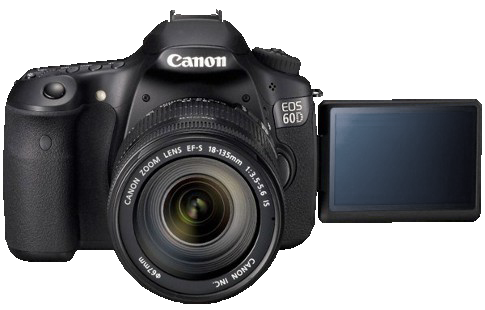60D Mega Review

Article by: Chad Stembridge
“It’s the best filmmaker’s DSLR out there right now.” – Stu Maschwitz.

There’s a reason he said that.
To date, I’ve had opportunities to shoot on four different dSLRs: the D5000 (we’re not even gonna go there…*shudder*), 7D, T2i, and now, the 60D (I sold a DVX and bought one a couple weeks ago). A few months ago, I compared the 7D and the T2i. The 60D fits in between the two, in price, size, and features. Well, on a lot of features.
But let’s not jump the gun. First off:
The Tech Specs
The 60D has the same APS-C CMOS sensor as the 7D, and, like its little brother the T2i, has only one DIGIC-4 processor (the 7D has two). And unlike its little brother, it shares the same control the 7D has in regards to ISO (100-6400, expandable to 12800) and shutter speeds (up to 1/8000 sec.).
Like the T2i, it records to SD, SDHC, or SDXC media. The 60D’s between the 7D and T2i when it comes to still frames per second, able to shoot at a little over 5 fps, compared the 7D’s 8 fps and the T2i’s 3 fps.
As for as the size, it’s just slightly smaller than its big brother, and definitely bigger than the T2i. I love how the 60D feels in my hand—my hands are bigger than many people’s, so the T2i feels too small to me. The 60D doesn’t have as much of the bulk and weight that the 7D does, but still feels good.

Practicality
Okay, enough of the comparing specs… Video’s what we’re interested in.
About 10 hours after my 60D (and Canon EF-S 10-22mm) arrived via UPS, I left to help shoot an outdoor-adventure documentary in Florida. My 60D definitely got a trial by fire. Here’s why:
I was primitive camping out in the wilderness for almost 6 whole days (hehe…besides the night we got rained out), the main shooter out in the woods with a father as he put his son through a rite of passage. There was a wide gamut of shooting environments and situations to deal with, from warm Florida days to cold nights, extreme low light, bright sunlight, forest, brush, dust, sand, dew, and water. Lots of water. Including rain, flash floods, and a 16 mile kayak trip (and yes, I did have the 60D with me on the river).
There are two big things that set the 60D apart from the others. One, the flip-out LCD. Two, manual audio controls.
LCD
I’ve shot with the 7D. I know how hard it is to see the fixed LCD on the back, especially when the camera needs to be in an awkward position to get the best angle.
Enter the 60D and the flip-out screen. Enough said.

Most of that data displayed on the screen in the photo above disappears once recording starts, but it’s super nice having that histogram displayed for setting up shots. There’s also the option to show the camera level display, instead of the histogram.
Audio
With the manual audio controls, one can theoretically record high quality audio directly into the camera. The onboard mic isn’t too terribly bad, if it’s in the right shooting environment, but almost any other mic is going to be able to capture better sound. There’s still no way to monitor sound while recording (no onscreen meters, and no headphone jack), but manual control is a step in the right direction for Canon.
I attempted plugging my Audio-Technica AT-897 into it via an XLR to 1/8″ adapter, and that was a no-go. After researching the problem online, turns it that the in-camera amp on the input messes up the incoming audio if there’s no pre-amp, which caused it to come out as a bunch of garbled hissing.
After ditching that idea, I went with the on-board mic quite a bit (which was surprisingly not that bad)—and then discovered that one of the lapel mics we had with us actually worked. I’m not sure what it was about it, but I was able to record clean audio directly into the camera using the mic…I’m guessing it was perhaps due to the mic going through the receiver first (which has a pre-amp?). I’m not sure why it worked, but it did.
It’ll take more experimenting to figure out a setup that gives as good results as plugging an XLR mic into a camcorder, but I think it can definitely be done. For now, I definitely wouldn’t trust the internal mic for any kind of narrative stuff, but for documentary or capturing reference audio for later syncing, it works fine.
Buttons!

As with the 7D, many of the controls on the 60D are on the outside, not buried in a menu. That makes it much more friendly than the T2i. My only complaint about it is that the Manual Mode and the Movie Mode are way too far apart on the mode selector dial…Almost on opposite ends, and there’s only one way to go around.

Taking a quick glance at the back of the 7D (here, and here), then looking at the 60D (above and right), there’s not too much of a difference. The 60D is missing the dedicated button for white balance on the top, as well as the custom function button next to the top dial. But it retains the back scroll wheel, which is extremely useful in my opinion.
I think the 60D also improves on the back scroll wheel, in that it combines the selector button with the wheel and center button (the 7D has a joystick control just above the wheel).
Because of the flip-out screen, there aren’t any buttons on the left side like the 7D has. Canon did a smart move in putting the delete button far away from any other buttons on the 60D; it’s directly to the left of the viewfinder, below the mode selector dial and power switch.
Though it’s also missing dedicated buttons for picture styles, RAW/JPEG, and white balance, all of those important things can be quickly accessed using the Quick menu, which has a dedicated button directly above the scroll wheel.
Image & Performance
The 60D performed amazingly well. It didn’t matter if it was during the day in full sun, kayaking down the river, or at night with the only light source being a lantern or campfire… Even shooting at super high ISO speeds. You naturally expect noise when your lighting is a dim campfire, shooting at ISO 3200. But believe me, there’s a big difference between doing that on the 60D, and doing it on a run-of-the-mill HD camcorder, even a prosumer-grade one. That big sensor is a HUGE advantage.
And of course, I’m shooting flat.
Click on the thumbnails to the left to see full-sized screen captures from three video clips: (top) fireside talk, campfire as the only light source (using Canon 10-22mm @ f/3.5, ISO either 3200 or 6400, can’t remember which); (middle) hiking, near-noon sunlight (using Tamron 28-200mm @ 200mm, ISO 100 I think); (bottom) and my brother, single incandescent bulb (using Pentax 50mm f/1.7, ISO 100).
Though it’s a CMOS sensor with a rolling shutter, I didn’t run into any real problems caused by that…The only hint of a problem was shooting at the long end of my Tamron 28-200mm. It’s not a very stable lens when it’s extended out that far, and a bit of jello would happen sometimes if there was a lot of wiggling going on. Despite this, I was able to get solid shots at 200mm.
The 60D can autofocus during video recording, but I don’t recommend doing it. For one thing, it’s not continuous autofocus; when you half-depress the shutter button to focus, it does the normal hunt-for-focus thing it does when you’re shooting stills. For another thing, it causes the video recording to glitch until the focusing is finished.
Because of its size, the 60D was the perfect camera for a project like the documentary in Florida. It was completely portable, lightweight, rugged, and gave a very good image (shooting with both the 10-22mm, and Tamron 28-200mm). I was extremely pleased with its performance.
Lenses
Quick little blurb about the lens I bought with it…Originally, I was going to go with the Tokina 11-16. But I wavered for a day or two, then finally settled on getting the Canon 10-22mm, and was very happy that I did. It’s a very sharp lens, produces accurate and pleasing color tones, and it’s super wide!

I also got a Fotodiox Pentax K mount to EOS adapter, so I can use all my Pentax glass. So far, that’s worked quite nicely. The only issue with it has been that every once in a while, the video will randomly flicker slightly darker for a frame or two…Not sure what’s causing that, but I’m thinking it could have something to do with the dandelion autofocus confirmation chip…
Sample Test Video…
Before we finish up, here’s a quick narrative-style test video I shot with my Mom and brother. Yeah, it’s cheesy, but I wanted to shoot a scene with the camera…
Shot mostly with the Pentax 50mm f/1.7 @ ISO 100, with one shot using the Canon 10-22mm @ 12mm, ISO 500 (I think).
The Card Game – 60D Test from Chad Stembridge on Vimeo.
Conclusion
There’s definitely a reason why the 60D is being called the best dSLR for professional video. Looking back, I’m quite happy with choosing it over the others. It’s definitely worth the extra money over the T2i, and unless the added photo features are needed for pro stills work, it beats out the 7D for video.
It’s well built, is capable of making great images, and provides the needed manual controls for any type of shooting. In the words of Stu:
“If you’re shopping for a DSLR right now, for the primary purpose of shooting video (being familiar with all the pros and cons), what you want is the Canon 60D.”

- - - - -
Source Article
Article by: Chad Stembridge









 Post a Comment
Post a Comment
Reader Comments